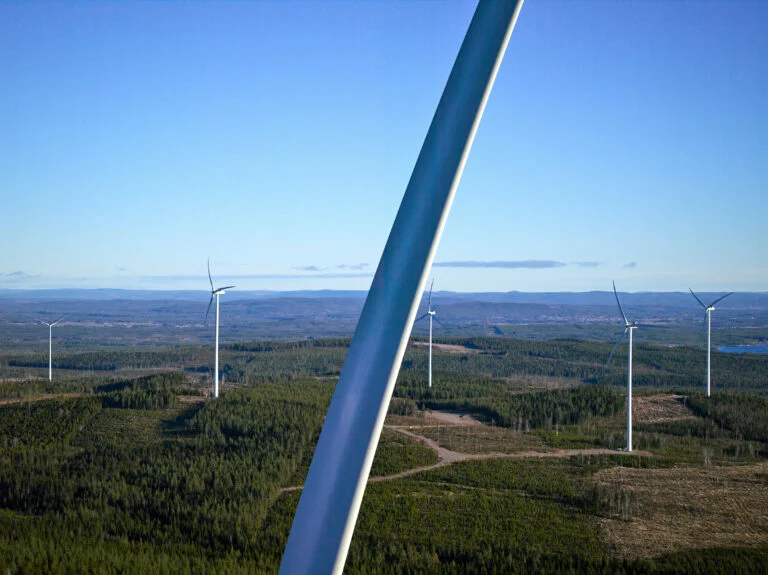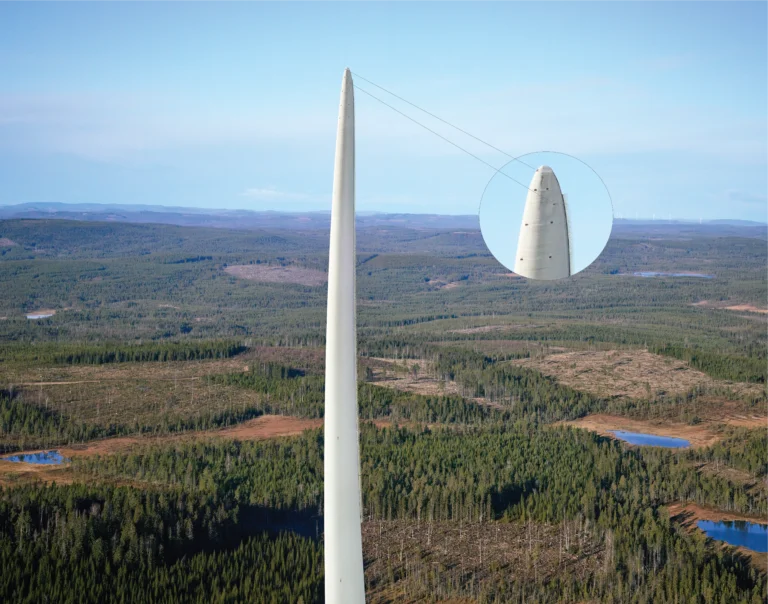



A Phase One Case Study
Drone Solution seeks to reduce costly downtime by using a UAV-mounted Phase One camera to capture high-quality imagery of wind turbine blades – while they are generating electricity.
Wind turbines need regular inspections to ensure their structural integrity. Until now, this has been done with manual inspections or drone inspections with lower-resolution cameras.
These methods usually require stopping the turbine, resulting in over an hour of lost operational time, or up to 6000 Euros in lost energy production. They also require personnel to be on site to control each turbine.
Capturing clear, detailed images while turbines are in motion requires maintaining safe distances from the blades without compromising image quality. In turn, this requires drone stability in the high-wind conditions typically found at wind turbine sites.

To survey a blade, a technician needs to be on site and needs to stop the turbine at the right position – with the selected blade at 12 o’clock – before calibrating and beginning their imaging work.
Due to the limitations of the sensors typically used in UAVs, they need to fly very close to the blade, at just 3 to 5 meters away.
Using a semi-automated Flight Pattern, UAVs follow a pre-set flight path around the stationary turbine to capture images of one blade at a time. Once one blade is inspected, the turbine must be rotated to position the next blade for inspection. Typically, this means setting the blade to the 12 o’clock position. If parts of a blade are missed during the survey, the entire inspection for that blade must be restarted.
This approach is very time consuming, as each complete blade inspection cycle, including rotating the turbine, can take up to an hour. During this time, the turbine must remain stationary, leading to downtime.
Using a fully automated option, this eliminates the need to rotate blades between inspections. The UAVs or integrated systems can inspect all three blades in one session. It is still required to set one blade to the 12 o’clock position initially, ensuring a proper calibration or starting point.
The advantages are clear: A significant reduction in downtime and faster overall inspection processes. In addition, companies benefit from reduced operational complexity as there’s no need to rotate the turbine between blades. Fully automated systems may require advanced UAVs, software, and calibration, which can be more expensive initially.
In summary, semi-automated systems may still be suitable for smaller operations or specific use cases, while fully automated systems offer efficiency for high-volume or large-scale inspections.

To capture high-resolution images of wind turbine blades while they are in motion, the team at Drone Solution sought a solution for inspecting turbines from 60 meters’ distance. This would ensure the safety of personnel and avoid accidentally hitting the moving blades.
Drone Solution wanted the unparalleled image clarity and stability that Phase One provides.
“We chose Phase One for their high resolution, durability, and adaptability in industrial inspection environments,” says Drone Solution’s Jorge Ramos.
They selected a Phase One P3 payload: an iXM-GS120 camera with an 80mm lens. The P3 iXM-GS120 is known for its ability to deliver clear, precise images at greater distances, making it suitable for safe, efficient inspection of moving turbines.
The team integrated the P3 iXM-GS120 with a DJI Matrice 350 UAV. Integration was smooth with a few adjustments necessary to ensure stable positioning and consistent angle capture, to meet the unique demands of moving turbine inspections.

The inspection results met high expectations, providing clear images of turbine blades without stopping the turbine.
“The Phase One P3 iXM-GS120 camera allowed us to capture clear, detailed images of wind turbine blades without interrupting operations,” says Jorge Ramos.
The Phase One camera allowed Drone Solution to capture detailed images with 12 shots per blade side, despite challenges from light interference due to the sun being low in the sky.
The DJI Matrice 350 UAV provided excellent stability in windy conditions, with the P3 camera’s stabilizer ensuring images remained free of blur.
After initially testing the system, Drone Solution has identified ways to improve it in future, including a method of labelling the blades to make them easier to distinguish from each other.
If you have questions regarding this case study or want to learn more, contact our Gresco Unmanned Autonomous Solutions team at [email protected] or call 478-315-0812.